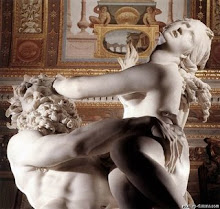skip to main |
skip to sidebar


 BABUREN, Dirck van
BABUREN, Dirck van
(b. ca. 1590, Utrecht, d. 1624, Utrecht)
Biography
Dutch painter (original name Theodor Baburen) who was a leading member of the Utrecht school, which was influenced by the dramatic chiaroscuro style of the Italian painter Caravaggio.
After studying painting with a portraitist and history painter in Utrecht, Baburen traveled to Rome about 1612. His most important Italian commission was the decoration of a chapel in the Church of San Pietro in Montorio, Rome (1615-20), which included his Entombment (1617).
In 1620 Baburen returned to Utrecht, where he shared a studio with Hendrick Terbrugghen in about 1622-23. The influence of Caravaggio may be seen in his Christ Crowned with Thorns (two versions, at the Franciscan House, Weert, Netherlands, and at Drury-Lowe Collection, Locko Park, England), based on a lost painting by the master. Baburen was especially fond of genre scenes (subjects from everyday life), such as The Procuress (1622; Museum of Fine Arts, Boston). A certain coarseness in conception, irregular compositional rhythms, and less atmospheric quality distinguish Baburen's art from that of his greater contemporaries, but his manner of painting can be said to be broad and forceful.



 BALESTRA, Antonio
BALESTRA, Antonio
(b. 1666, Verona, d. 1740, Verona)
Biography
Italian painter and printmaker. His altarpieces and history paintings, which unite late Baroque classicism with Venetian colour, brought new life to north Italian painting. The son of Lucia Boschetti and Francesco Balestra, a wealthy merchant, he studied literature, rhetoric and the humanities, but, after lessons in drawing and perspective with Giovanni Zeffis (d. 1688) and one Monsignor Bianchini (1646-1724), he moved to Venice in 1687 and trained with Antonio Bellucci. In 1691 he transferred to Rome, where he studied with Carlo Maratti, whose art continued a classical tradition that can be traced back to Raphael, and where he also absorbed the work of Annibale Carracci and Domenichino. In 1694 Balestra's large drawing of the Fall of the Giants (Rome, Galleria Accademia Nazionale di S Luca) won first prize in a competition at the Accademia di S Luca. In 1695 he returned to Verona, where he was acclaimed as the chief exponent in the Veneto of Maratti's late Baroque classicism. His pictures of this period were mainly small religious works, such as the Agony in the Garden (private collection). In Verona he established a school of painting.
His masterpiece, the Recovery of the Bodies of Sts Cosma and Damian, is in the Basilica di Santa Giustina in Padova.



































.jpg)
















